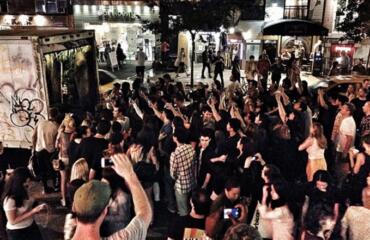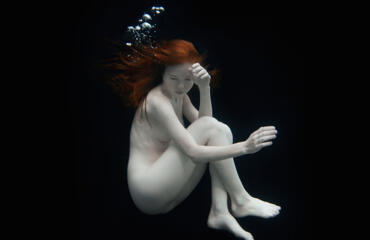
Stand-up comedian Simon Munnery: “How’s it going to end? Maybe I’ll die in a ditch?” PIC: Supplied
“Heckling has really died out as an art form,” says stand-up comedian Simon Munnery, adding a teaspoon of sugar to the splash milk in his cup and stirring. “The only existing video footage from [legendary comedy club] The Tunnel is of me getting heckled.”
He cups his hands to his mouth and turns his head, mock-calling: “Cab, Simon Munnery.”
He turns his head in the other direction and adds, slightly raises his voice, “I’ll pay”.
Back the other way, “So will I.”
“Pass the hat ‘round.”
Munnery is celebrating his 30th uninterrupted year of working as a stand-up artist and is visiting Melbourne to perform his two shows And Nothing But and Fylm School. If his choice of beverage in the Melbourne inner-city café-bar in which we meet doesn’t give his nationality away, his tweed hat, eccentric brand of absurdist humour and easy way with vowels certainly does.

“That’s how I met my wife,” he continues, sipping his tea. “She heckled me. ‘Don’t die’, is what she said. And my reply was, ‘where were you at Calvary?’ Which immediately confused almost everyone in the room.”
Confusion seems to be a state Munnery embraces with enthusiasm, both creatively and in conversation. Questions inspire tangents and anecdotes, points are illustrated using pop culture, existential philosophy and sports history.
A cursory look at his recent stage shows reveals a riot in DIY surrealism. This year’s show Fylm School involves live cardboard animation, puppetry, video, mime and rapping. Sadly, two recent passions — boat building and Morris dancing — are absent.
“For last year’s comedy show I made a foldable eight-foot high by eight-foot wide proscenium arch. My criteria for a show is: will it fit in a suitcase?”
‘Many are willing to suffer for their art. So few are willing to learn to draw.’
While studying at Cambridge University, Munnery’s love of comedy grew as enthusiasm for his natural sciences degree waned.
He was accepted into the university’s legendary Footlights theatrical club by slapping himself on the face with a ripe tomato and saying the words “slapstick lives”. That he is still involved in the industry nearly 40 years later is a feat that requires explanation.
“I suppose I’m addicted to it, that’s the simplest answer,” he says, as if pondering his achievement for the first time.
“I love being able to think of a thing and try it out without asking anyone. If I’d known I was going to have a wife and children I’d have done something more lucrative, like rob a bank.
“Laughter is what laughter is. You think you like something but [scrunching his face and pausing] . . . Søren Kierkagaard said ‘People demand freedom of speech as a compensation for the freedom of thought which they seldom use.’ So, you can imagine anything you like, but what can you get away with on stage that’s interesting? To what extent is there a ‘we’? The essentialness of the audience is both the greatest thing and the worst thing about performing stand-up.”
‘A million monkeys have been given a million typewriters. It’s called the internet.’
Known in England as ‘the comedian’s comedian’, much to his shrugging bemusement, Munnery has somehow avoided running the gamut of BBC panel shows and guest spots with Stephen Fry.
“Surprises me too,” he says. “If they ask the answer is ‘Yes’, but I don’t actively pursue things. I don’t like having meetings or writing proposals, you know what I mean?” He raises his eyebrows in question.
“For me, if you make a thing you start off on a journey and you don’t know where it will go. It’s not until you look back on something that you can properly describe it. When I write a blurb for a festival about a comedy show like this one I have no idea what the show will be like.
“A lot of writing goes into it, but hardly any of that is actually in the show. At the end of its first run in Edinburgh, some parts dropped out and a lot of new stuff is in there and before too long I can’t remember how I came up with it. It solidifies, and then you chuck it away and start again.”

Munnery’s relationship with street artist Banksy may not be the work for which he is best known, but it does illuminate a mystery over which millions obsess.
A mutual friend has told me that after working on the door of a London comedy club, she became very familiar with Munnery’s material and was surprised to see it recycled by graffiti artist and activist Banksy in interviews. After contacting a representative of Banksy via email to point this out, the artist apparently made contact with Munnery, anonymously gifted him artwork and engaged his services as a writer. I put this story to him.

“Ummm,” he sighs, before examining the table. “Print the myth. Her story may be true and that’s the amazing thing,” he says cryptically. Munnery begins to move objects on the table to form a wall around my voice recorder. First the teapot, a glass, then the milk jug. He launches into a story I recognise from other interviews.
“Look, what happened to me was I was running a club in Stoke Newington in London. It was the end of the gig, and it might look to someone else like everything is over but I’ve got to pack up. I’m still wired.
“A bloke came up to me and said ‘Excuse me. I’m a graffiti artist and I’ve been spraying some of your lyrics on walls’, and I went: ‘Have you? Great. Good luck with it. I’m just packing up.’ About a year later, exactly the same thing happened at another gig in Stoke Newington only this time he said ‘I’m Banksy’. And I said ‘Ahhh. That’s fine. I don’t mind at all’.”
By now a sugar bowl and a coffee cup have joined the wall around my voice recorder. I ask him about another story our friend told me, that he wrote the Academy Awards acceptance speech never given for Banksy’s Exit Through the Gift Shop.
‘Do not punish yourself, you deprive the world of its purpose.’
“No. I did do some script editing on that though. He’s the sort of person . . . he rings me I don’t ring him, because he changes his phone about every six hours. Sometimes he wants help thinking about a thing or content you could put in a certain space. I did a gig in Dismaland and he put some of my things in the brochure – lyrics and jokes.”
As to Bansky’s identity, Munnery brings his gaze back up from the table.
“I prefer the myth.”
I quiz him on his use of the phrase “print the myth”. Munnery’s reply immediately involves recounting Muhammad Ali failing his first Vietnam draft, accidentally dismissing Matt Groening with a cursory ‘thanks’ after a show in Aspen, Colorado, and a story about charging McDonalds £10 million to appear in one of their advertisements.
‘All men are brothers. Hence war.’
“In the end, they got someone who was so similar to me that on the tube I’d have people coming up to me and saying ‘Are you in that McDonalds advert?’ ”
But, “print the myth” ?
“Isn’t that a saying, ‘the truth or the myth’? That the essence of the story is more important than the truth? I don’t know! The truth is infinite.”
Munnery’s work with Banksy feeds into his love of the unexpected and the unexplored, an intimate driver of his career.
“How’s it going to end? Maybe I’ll die in a ditch?” he laughs. “I have immense kinship and feelings of love for anyone who has been doing it as long as I have, or longer. So many people have given up, and I miss them.”
► Simon Munnery And Nothing But
Melbourne Town Hall, Until 17 April, 9.45pm (8.45pm Sundays)
► Simon MunneryFylm School
Melbourne Town Hall, Monday 11 April, 8pm


